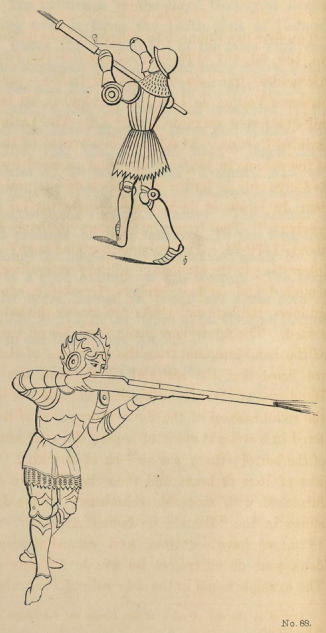
Try Amazon Audible Plus
Ancient armour and weapons in Europe: from the iron period of the northern nations to the end of the seventeenth century: with illustrations from contemporary monuments, Volume 3 by Hewitt, John, 1807-1878
PLATE 88.
 A larger image of Plate 88, handgunners, in Ancient armour and weapons in Europe by John Hewitt. |
The first hand-gunner here figured is from Burney MS., No. 169, fol. 127.
The manuscript is “Des fais du grant Alexandre, translate du latin en francois par venerable personne Vasque de Luce, ne portugalois, en lan de grace mil quatrecent soixante huit,” &c.
The Latin is that of Quintus Curtius.
At folio 13 is a record of the purchase of the volume in 1475: it was then acquired by “phelippe de Cluys chlr̅ de lordre saint jehan de jherusalem, com̅andeur du blison et de la vaude, achete par lui en lan mil ccclxxv.”
The transcript appears to have been made about 1470-74.
The volume contains many miniatures interesting to the student of military antiquities.
Knights mounted and on foot, archers, Greek-fire, cannon, hand-gunners, combats and jousts are among the represented.
The figure here given furnishes an early example of the hand-gun, and from the colouring of the miniature we learn that the material of the arm was iron.
The Hand-gun of this time differed in nothing but its size from the small cannon of the day : it consisted of a metal tube fixed in a straight stock of wood ; the vent was at the top of the barrel ; there was no lock of any kind.
The barrel was of iron or brass, and the these barrels were occasionally furnished with moveable chambers.
In the Inventory of stores in the “Bastide de Sainct Anthoine” at Paris in 1428, we have :— “Item, xvii. cannons a main, dont les deux sont de cuivre, et les xv. de fer sans chambres.”
The example found in the old castle of Tannenberg (noticed at p. 299) is of brass.
An early mention of the hand-gun is that of Juvenal des Ursins, who tells us, under the year 1414,
that “Au siege d'Arras y avoit un canonier, lequel so mit dedans la ville, et dit tout l'estat de l'ost, et le gouvernment, en les exhortant qu'ils se tinssent bien et se defendissent.
Et auss faisoient-ils ; et souvent sailloient, et avoient belles retraites, et lieux: propices à eux retraire.
Mais toutes les fois qu'ile sailloient dehors esdits lieux, il y avoit bonnes arbalestres, archers, et canons à main pour los recevoir, et en toutes les sorties qu'ils firent, ils furent reboutés à leur grand dommage.”
Hand-guns are mentioned in the Paston Letters in a missive from Norfolk written about 1459:—"They have made wickets on every quarter of the house (at Castor) to shoot out of,
both with bows and with hand-guns; and the holes that be made for hand-guns, they be scarce knee-high from the planchar.” (Vol. i. p. 88, ed. 1840.)
It is not till the second half of the fifteenth century that any pictorial example of the hand-gun is found.
The miniature before us is one of the earliest. The arm again appears in the second illustration, from Roy. MS., 18, E, v., fol. |
Source: pp. 484-486, Ancient armour and weapons in Europe: from the iron period of the northern nations to the end of the seventeenth century: with illustrations from contemporary monuments, Volume 3 by Hewitt, John, 1807-1878
Other 15th Century Illustrations of Costume and Soldiers
